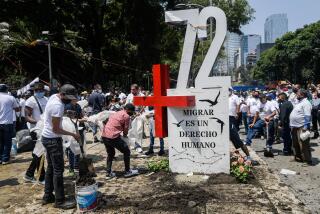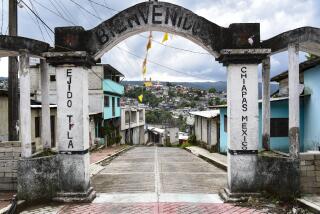Salvadoran Rebels Stepping Up Attacks : Bloodiest Fighting in 3 Years Calls Into Question Army’s Tactics
- Share via
SAN SALVADOR — The fall offensive of El Salvador’s guerrillas intensified during the past week, with the rebels operating freely in and around the capital and staging a series of successful attacks on government forces. With at least 37 people killed in the fighting since last Sunday, the violence has reached its bloodiest level in at least three years.
At the same time, human rights organizations assert that government security forces are responding with more and more abuses of suspected civilian supporters of the rebels.
The new guerrilla aggressiveness has put the military on the defensive, particularly in San Salvador and surrounding provinces, and has called into question the effectiveness of government forces in carrying out American-devised counterinsurgency measures.
The clearest example of both renewed rebel pressure and the army’s inability to deal with its enemy’s thrust came in the early morning darkness last Wednesday.
An estimated 200 members of the Farabundo Marti National Liberation Front, the command structure for the five Salvadoran guerrilla groups, overran an army base camp atop Guazapa Volcano, killing at least 12 soldiers and wounding dozens of others.
Rebel Stronghold
Guazapa, which is only 15 miles north of San Salvador, had been a rebel stronghold until the past year, when an army operation drove them from the slopes of the volcano. Col. Juan Carlos Orlando Zepeda, commander of the brigade that operates in the area, said in a recent interview that the FMLN, as the guerrilla organization is commonly called, was no longer capable of effective action in the area.
The Wednesday attack proved him wrong. According to military experts, the guerrillas were able to climb the 1,500-foot peak in the dark carrying heavy mortars, machine guns and mines without detection, indicating a well-organized infrastructure.
“It also indicates that the army still isn’t following key elements of counterinsurgency tactics,” one European expert said. “It was clear that there were no nighttime patrols and that the army failed to set up adequate defenses.”
American military advisers have been stressing for years the need for the Salvadoran military to abandon a 9-to-5 mind-set that usually has commanders pull their troops in at night, either to barracks located in major cities or to large base camps such as El Roblar on the top of Guazapa.
The recommended strategy is to send out small patrols, normally eight to 15 soldiers, at night, set up ambushes and seek out the enemy. That tactic, with only a few exceptions in the eastern provinces, has been resisted by most army commanders.
Even when small, mobile patrols are used, they tend to stay on the roads, rather than working in the hills and valleys that mark most of the nation’s countryside, making it easy for the guerrillas to move and hide.
It also leaves the rebels relatively free to place remote-controlled mines on roads and to set up ambushes that now regularly attack military convoys hauling troops back and forth from their barracks every morning and evening.
The FMLN staged such an ambush Tuesday morning when guerrillas destroyed a large troop carrier, killing four soldiers, capturing many weapons and escaping without casualties.
The attack took place near the town of Nejapa, 9 miles north of the capital and the constant scene of serious FMLN activity. “You would think that they (the army) would regularly work that region,” said a European diplomat with good rebel contacts, “but by sticking to the roads, they in effect give the FMLN the countryside.”
That same morning, the guerrillas destroyed an electrical substation in the same town, killing three soldiers.
The attacks seemed to be coordinated to take advantage of what is a routine army reaction. First the substation was attacked. The army responded by sending a convoy to reinforce guards at the substation. The guerrillas then ambushed the army vehicles. It is a scenario that occurs throughout the country nearly every night.
What is also becoming commonplace are quick guerrilla overnight takeovers of towns, often close to San Salvador. The most recent occurred just after midnight last Sunday when a large band of rebels entered Colon, a city on the Pan American Highway about 5 miles west of the capital and no more than a mile past one of the army’s largest bases.
The guerrillas called the townspeople together, destroyed the city hall and gave political lectures, staying for nearly seven hours without detection by the military.
The army’s new chief of staff, Col. Rene Emilio Ponce, says he is an enthusiastic supporter of American counterinsurgency theory. And as brigade commander recently in San Miguel and Morazan provinces, two areas of intense conflict during the eight years of guerrilla warfare, he himself used such tactics with considerable success.
Yet the decentralized organization of the army essentially prevents him from forcing battlefield commanders to use the tactics, with many still preferring large-scale daytime operations that usually are easily evaded by the guerrillas.
Several commanders also are resuming methods that are seen by human rights workers as abuses of civilians suspected by the army to be supporters or sympathizers of the FMLN.
The body of a man who had been tortured and then decapitated was found early in the week dumped in an area near San Salvador in a manner reflecting methods used in the past by death squads presumably sponsored by or approved by the military.
Human rights workers also said there were signs that death squads had executed four men suspected of having attacked soldiers guarding a civilian bus.
The army denies the charges, but investigations by journalists and independent human rights groups indicate an increase in military abuses, although not yet at levels reached in the early 1980s.
Still, the army appears to be trying to weaken the guerrillas by frightening and punishing the civilian population, another deviation from U.S. counterinsurgency theory, which calls for leaving noncombatants alone, even if it means allowing sympathizers to exist.
In northern Morazan alone in the last two months, the army has illegally arrested at least 69 civilians in one village, according to human rights workers.
Several of these people agreed to talk to foreign journalists, saying they were tortured and badly beaten. Many said their arms were handcuffed to walls at levels so high they could neither move nor sit down. Others told of being beaten unconscious, blindfolded for days and given injections that knocked them out.
The army commander in San Francisco Gotera, Morazan’s main town, denied abusing prisoners but acknowledged that many civilians have been arrested and held.
In the same period, human rights workers say that at least six civilians have been killed by soldiers. The army denies that report, saying that most of the deaths were caused by the guerrillas.
In fact, the FMLN is continuing a tactic of killing elected mayors and other government officials in eastern El Salvador. The latest such episode occurred in the San Miguel provincial town of Sesori, where the mayor was slain by guerrillas last Sunday and the mayor’s secretary was kidnaped and presumed killed two days later.
The guerrillas say they intend to keep intensifying the war. As part of that effort, guerrillas took over two radio stations in San Salvador on Tuesday and forced announcers to broadcast a warning that the U.S. Embassy and all Americans living in the country are considered legitimate targets and will be attacked.
More to Read
Sign up for Essential California
The most important California stories and recommendations in your inbox every morning.
You may occasionally receive promotional content from the Los Angeles Times.










